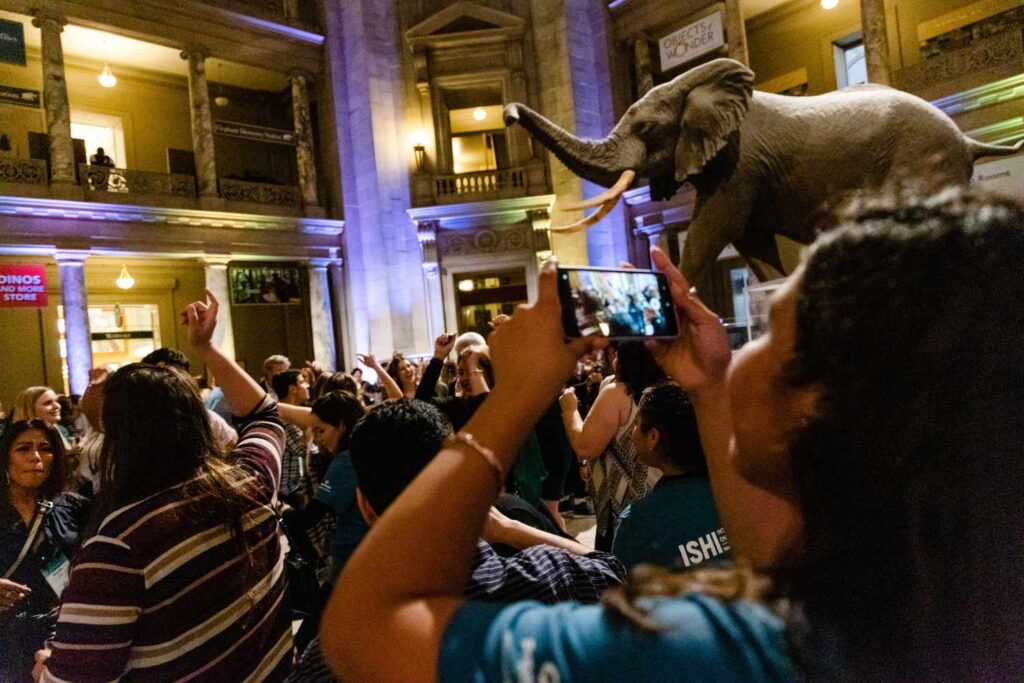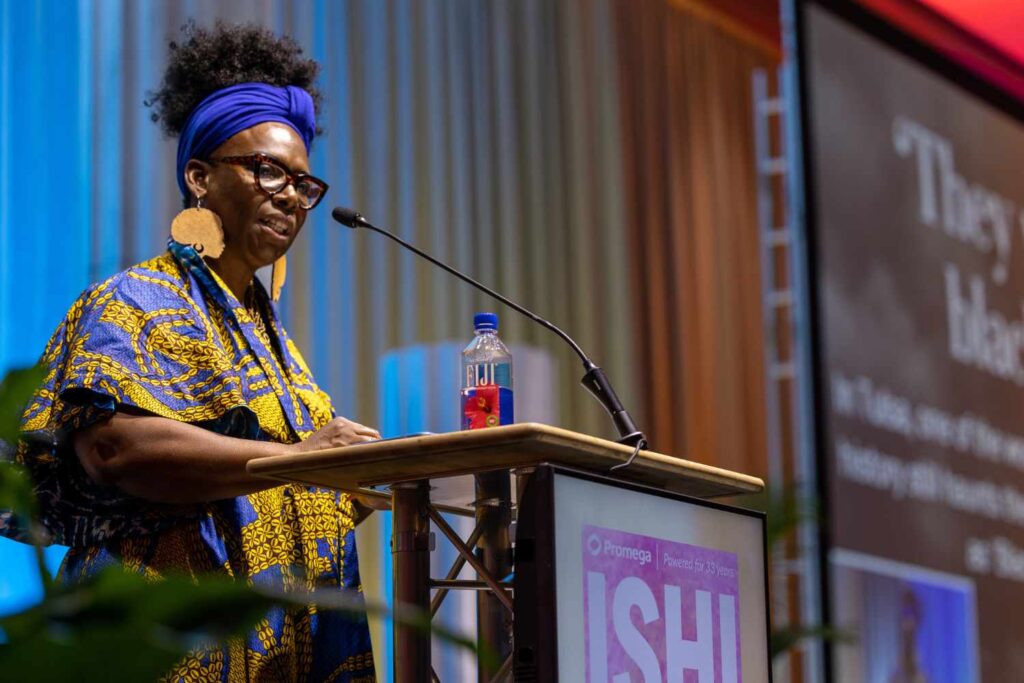It’s hard to imagine a better way to celebrate the 33rd International Symposium of Human Identification than a night spent wandering through the Hall of Human Evolution at the Smithsonian Museum of Natural History. The meeting, which took place in Washington D.C. from October 31–November 4, focused largely on using investigative genetic genealogy (IGG). When used to identify human remains or solve cold cases, IGG (a.k.a. forensic genetic genealogy or forensic investigative genetic genealogy, take your pick) relies heavily on techniques developed to sequence DNA from ancient human remains.

New to ISHI this year were live-streamed presentations, building off the success of last year’s session recordings for online streaming. Another first was attendees dressing up in costume for the welcome reception, which happened to coincide with Halloween. From a nucleic acid-themed group costume to Sims characters to a bunch of grapes, ISHI 33 attendees had a chance to show off their fun side while reconnecting with colleagues.
While a range of topics were covered during the workshops, sessions and poster presentations, three themes stood out to this first-time ISHI attendee. In addition to IGG, there was widespread interest in developments in DNA databases as well as efforts to mobilize DNA analysis labs.
The Wild West of Investigative Genetic Genealogy
IGG is a technique used to identify human remains or cold case crime scene samples by tracing potential genetic familial relationships through genealogical DNA databases. One of Monday’s workshops, “Investigative Genetic Genealogy: A Comprehensive Review”, outlined the laboratory methods, bioinformatics tools and databases that enable IGG. Danny Hellwig (Intermountain Forensics) provided an overview of how to isolate high quantities of DNA from highly degraded samples and compared the pros and cons of different instruments—microarray, next generation sequencing and whole genome sequencing—for sequencing those samples. Kevin Lord (DNA Doe Project) discussed how bioinformatic tools help process the huge amount of data generated from sequencing and how methods like imputation help fill in gaps to prepare sequences that are high enough quality to upload to DNA databases. They emphasized that these DNA extraction and bioinformatics methods are relatively established practices that were developed originally for sequencing DNA from Neanderthals and other ancient human remains.
More recent updates to those techniques were on display during Ed Green’s (University of Californica, Santa Cruz) Wednesday talk on extracting useable DNA from rootless hairs. By prioritizing extraction of short DNA lengths, Green showed how a rootless human hair sample can provide a similar call rate as a saliva sample.
In contrast, using genetic information to establish familial relations and determine the identity of the original sample or unidentified remains is a recent advance for the forensics community. CeCe Moore (Parabon), Margaret Press (DNA Doe Project) and Alison Wilde (Cold Case Coalition) presented methods for carrying out these genealogical investigations, including how to use the two DNA databases that are available to law enforcement and best practices for ethical application of IGG. They emphasized the need for standard methods and approaches that will help IGG progress from what they characterized as “the Wild West.”
Tuesday’s keynote sessions focused on the Tulsa Race Massacre and the efforts to use IGG to identify bodies recently uncovered in an unmarked mass grave in a Tulsa, Oklahoma graveyard.
Read more about these efforts in our May issue of the ISHI Report.
DeNeen Brown, a Washington Post reporter, spoke about the history of this and other massacres committed against Black people in the United States and exhorted the audience to “afflict the comfortable and comfort the afflicted.” Hellwig provided updates about Intermountain Forensics’ work with unidentified remains found last summer in Tulsa’s Oaklawn Cemetery. From the 14 samples, usable quantities of DNA were extracted from two teeth, but no DNA was extracted from the bones. Additional samples were collected during a second exhumation that occurred in October 2022. Work to sequence the extracted DNA and assess the new samples is underway.

Colleen Fitzpatrick (Identifinders International) and Nathan Scudder (Australian Federal Police) also gave talks on IGG. Fitzpatrick discussed the risks and benefits of IGG, including how IGG, which relies on single nucleotide polymorphisms (SNPs), introduces more privacy concerns than other DNA forensics tools like Y-STRs. Fitzpatrick also highlighted the legal, technical and genealogical ways IGG has evolved over its five-year history, likening the developments to the analog to digital transformation. Scudder discussed international developments in IGG and recommended that an international working group be established to ensure consistent use of IGG in the countries that adopt it as well as a guidance document that helps standardize the field.
Updates in the World of DNA Databases
Genetic genealogical databases are a key tool for IGG, and, as such, were a major topic of discussion at ISHI 33. Multiple speakers emphasized that only two databases—GEDmatch and FamilyTreeDNA—currently allow law enforcement officers to access their data and submit samples. Because there are privacy concerns associated with DNA databases, it was emphasized that users closely follow databases’ Terms of Use, and that failure to do so can jeopardize cases, public opinion and legal use of these tools. There was also informal chatter around the possibility of a database that was not owned by for-profit organizations.
François-Xavier Laurent (INTERPOL) presented a new database, I-Familia. INTERPOL developed this as an international database that allows close family members of missing persons to submit DNA for a potential match to unidentified remains. In the presentation, Laurent noted that 25% of missing persons cases have a transnational dimension, including tourism, migration and trafficking. Furthermore, the missing person’s DNA is available in only 30% of cases, making direct matching impossible. I-Familia, which uses STR loci, is now used in 68 countries and has helped make three confirmed matches and 40 pending matches. Laurent shared one example. In late 2004, an unidentified body was found in the Agean Sea. Using I-Familia, those remains were matched to an individual who had been reported missing in Italy only a few weeks before the body had been found. Laurent concluded by noting that CODIS data can be exported to I-Familia.
Read more details about the data analysis behind I-Familia in this peer-reviewed article.
The next day, Ray Wickenheiser (New York State Police Crime Lab System) argued for Enhanced DNA Indirect Matching (EDIM) to expand criminal DNA databases beyond direct matching capabilities. Such a database would go beyond the core CODIS loci to include search keys for Y-STRs, X-STRs, mtDNA and, perhaps, SNP data. He included a business case and ethical considerations for an expanded database.
Douglas Hares (FBI) shared how Rapid DNA technology is helping standardize DNA collection from arrestees and how Rapid DNA profiles can provide potential hits to criminal DNA databases within 24 hours of booking. Louisiana became the first state to use Rapid DNA at the booking station in April 2022. Using the platform, the state identified three hits in three weeks, one to the National DNA Index (NDIS) and two to the DNA Index of Special Concern (DISC). Work is underway to determine potential improvements to help Rapid DNA meet quality assurance standards. Hares shared plans to have standards for modified Rapid DNA, which require a DNA analyst to interpret the Rapid DNA results, potentially published by 2025.
Mobilizing DNA Analysis—A Case Study and a Warzone
Mobile DNA labs can be used to provide identification of human remains in mass casualty incidents. However, implementing these labs is a major logistical challenge.
Julie Conover Sikorsky (Palm Beach County Sheriff’s Office) presented how her team used detailed planning to design, implement and validate a mobilization effort for their Rapid DNA infrastructure. With only a $6,500 investment (not including instruments), Sikorsky’s team was able to equip themselves for a field test of a new mobile lab. However, the emphasis of Sikorsky’s presentation was on the planning efforts rather than the cost of the field test. She has made her team’s planning documents available to the forensics community.
On the last day of ISHI, Sylvain Hubac (French Gendarmerie) shared how a mobile DNA lab patented by the French Armed Forces was deployed by the French government to the city of Bucha in Ukraine to aid in the identification of bodies left behind by occupying Russian forces. In April and May 2022, the lab was transported to Ukraine with a team of 16 forensics experts. In five weeks, the DNA analysts carried out 200 DNA analysis from bodies in varying stages of decay and from victims’ families. Hubac noted this was the first use of the mobile unit in a war context. The team trained 11 Ukrainians on the mobile unit’s DNA analysis workflow, and the mobile unit was later implemented to identify remains from mass graves found in Izyum, Ukraine.
Conclusion
The other presentations at ISHI 33 ranged from the customary updates about CODIS and DNA testing standards to graphic descriptions of cases where DNA analysis proved instrumental. However, one speaker and her story stood out. Ashley Spence, the founder of the DNA Justice Project, shared a powerful testimony to how Rapid DNA and closing gaps in DNA collection of criminal offenders can bring justice to victims. Spence was the victim of a brutal home invasion rape. DNA evidence collected from her body was critical for identifying and convicting Spence’s attacker, who was given a 138-year sentence. As a testament to the power of DNA, Spence has the loci for her STR profile printed on her business card. Spence also emphasized how much she valued the compassion and diligence of the officer, nurse, detective, DNA analyst and prosecutor who helped bring closure to her case.
Echoing Brown’s exhortation to comfort the afflicted, Spence’s testimony reminded ISHI 33 attendees of their work’s ultimate purpose—to pursue justice for victims.
ISHI 34 will be held in Denver Colorado next year. Until then, make sure to stay up to date with the ISHI report and follow the latest updates in DNA forensics in the ISHI blog.
Related Posts
Latest posts by Jordan Nutting (see all)
- The Central Dogma of Promega: The Story and Science Behind Our Kit Packaging Design - May 7, 2024
- Silencing the Immunogenicity of AAV Vectors - April 4, 2024
- Discovering Cyclic Peptides with a “One-Pot” Synthesis and Screening Method - February 29, 2024
